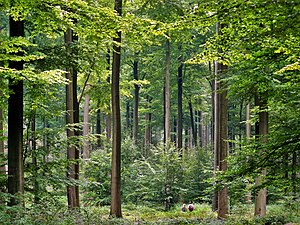 Image via WikipediaBy Ali Withers
Image via WikipediaBy Ali WithersPerhaps we should take some of the responsibility for the conflict about what is best for the environment and the planet rather than blaming it all on commercial interests. Commercial organisations exist to respond to the demands for their goods and services, although it is also true that in order to survive and grow they need to "create" new demands for new products.
We can't any longer ignore the effects continuous growth is having on the earth's atmosphere and environment and one of the biggest causes for concern is the loss of forests.
Trees and forests are important for a whole variety of reasons but two of the most significant are their effects on the air we breathe and the health of the soil we depend on for the food we need. Not only do they produce the oxygen without which we could not exist but they also help clean the air. A mature leafy tree produces as much oxygen in a season as 10 people inhale in a year and trees intercept airborne particles, reducing heat, and absorbing such pollutants as carbon monoxide, sulphur dioxide, and nitrogen dioxide.
Trees remove this air pollution by lowering air temperature, through respiration, and by retaining particulates. They also lock up carbon dioxide, identified as a cause of global warming. In order to produce its food a tree absorbs and locks away carbon dioxide in its wood, roots and leaves. A forest is a carbon storage area and can lock up as much carbon as it produces.
Trees also help clean the soil, either storing harmful pollutants or actually changing them into less harmful forms. They also help fight soil erosion. Their roots bind the soil and their leaves break the force of wind and rain on soil, but they also act as wind breaks, which can also reduce the drying effect on soil and vegetation behind the windbreak and help keep precious topsoil in place. They can also help reduce flooding.
More than 25% of our modern medicines originate from tropical forest plants. Even so, we have only learned how to use 1% of these amazing plants. This could prove to be a rich source for the Biopesticides Developers currently working to produce less harmful low-chem agricultural products, such as biofungicides, biopesticides and yield enhancers, to replace the older generation of chemical based products that are increasingly being taken off the market amid growing concerns about harmful and unhealthy residues in our food.
When you consider all this the ongoing destruction of rainforests particularly in the Amazon and Indonesia seems like sheer lunacy.
But there are so many tree-based products that we take for granted and can't imagine living without - whether it's building materials, furniture, paper, palm oil or the foods they produce, such as nuts and fruits.
While there are many organisations battling to protect the world's fast-diminishing rainforests, and across Europe paper is now largely sourced from sustainable forests, there are equally powerful interests, like mining, logging, oil and gas companies whose activities are important to the Peruvian economy, resulting in attempts by the Government to expel the catholic missionary Paul McAuley, who campaigns on behalf of the Amazon Forest's indigenous people and their local environment.
In Indonesia it's the huge profits to be made from forest plantations for palm oil and paper that are threatening the rainforests. It's not all doom and gloom, however. There's evidence in Africa that a particular tree can have an impact on climate change and increase maize yield.
The World Agroforestry Centre (ICRAF), recently highlighted some of its recent research, designed to increase maize production in Africa by up to four times by planting trees that act as organic fertilizers.
The tree that is the secret to higher maize yield, Faidherbia, has special nitrogen-fixing property and an unusual habit known a "reverse leaf phrenology". Unlike other trees, Faidherbia sheds its leaves and goes dormant during the early rainy season. Its leaves grow again only in the dry season, which makes it compatible with food crops because it does not compete with them for water, nutrients or light.
According to the Agroforestry Centre, Malawian farmers in Malawi say it is like "fertilizer factory in the field", as it takes nitrogen from the air, fixes it in the leaves and subsequently incorporates it into the soil. Where a tree canopy has been established maize yields increased by 280 per cent compared with the zone outside the tree canopy. In Zambia, too, unfertilized maize yields in the vicinity of Faidherbia trees averaged 4.1 tonnes per hectare, compared to 1.3 tonnes nearby but beyond the tree canopy. Plainly there's more to trees than most of us imagine.
Copyright (c) 2010 Alison Withers
Rainforests and trees are often cited as crucial to the planet's survival and to reducing global warming. But trees are valuable for much more than that. Aside from the products they produce they also protect soil quality and forest plants are the source of many modern medicines and, journalist Ali Withers argues, could be a useful resource for Biopesticides Developers.
Article Source: http://EzineArticles.com/?expert=Ali_Withers
http://EzineArticles.com/?Forests-Do-Much-More-For-the-Planet-Than-Locking-Up-Carbon-Dioxide&id=4751243

No comments:
Post a Comment